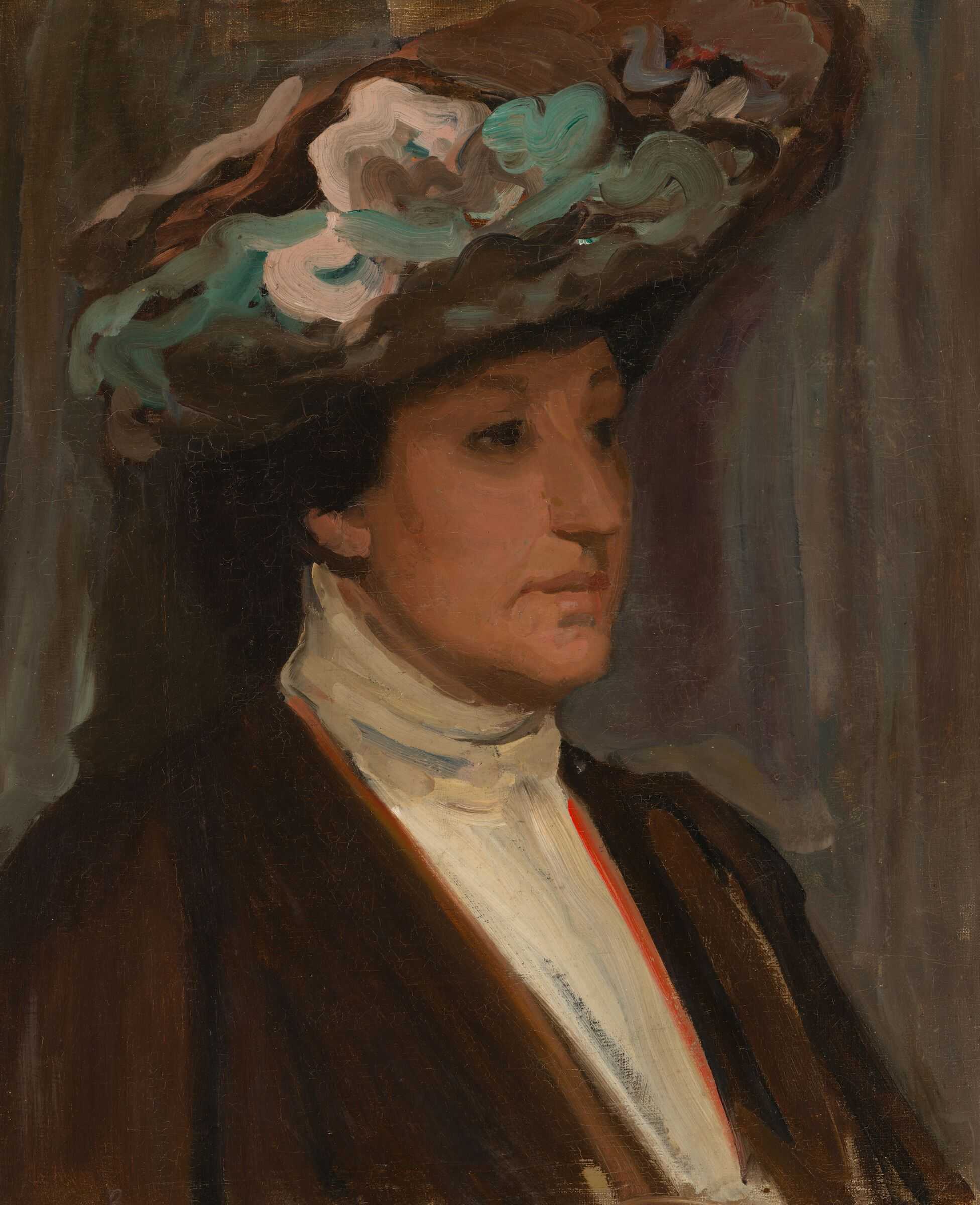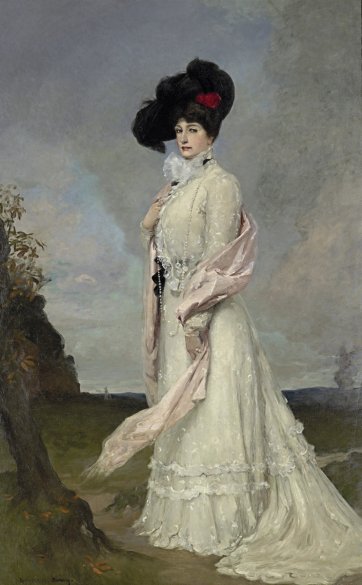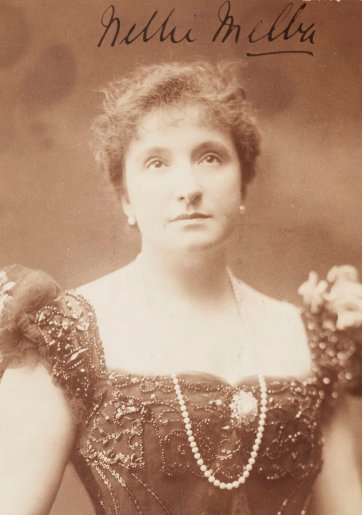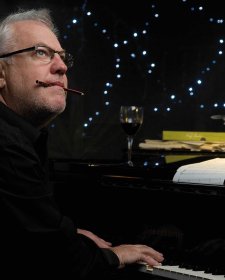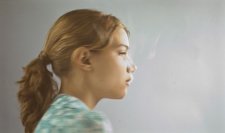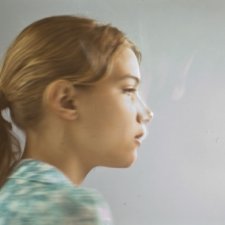‘Is it too much to call her the greatest Australian?’ asked the Argus on the occasion of the death of soprano Dame Nellie Melba in 1931. Of course, the National Portrait Gallery does not rank its portrait subjects in order of greatness. That said, there is a small group of individuals of whom virtually any portrait representation, be it however small, slight or faint, is desirable – and Melba is a member of that group.
The National Portrait Gallery recently acquired three tiny sketches of Melba by the artist who was to go on to paint the most imposing representation of the singer: Melbourne-born expatriate Rupert Bunny, who worked in France for nearly fifty years.
Rupert Bunny studied architecture and engineering at the University of Melbourne as well as art at the National Gallery of Victoria School from 1881 to 1884. That year, he went to Paris with his father, a judge; he was not to return to Australia permanently until late in 1933. Deborah Edwards, curator of the recent Bunny touring retrospective exhibition, makes a convincing case for his having been ‘the most successful painter to have left these shores’. Certainly, he enjoyed more success than any other Australian painter in Paris, progressing through successive, distinct artistic styles and subjects while living close to the heart of the action in those tumultuous decades in art.
In the early 1900s, Bunny lived in London. There, he socialised with other Australians including the musicians Percy Grainger, Ada Crossley and Nellie Melba – of all of whom he made portraits. Dame Nellie Melba gbe (née Helen Mitchell, 1861–1931) studied in Australia under Pietro Cecchi and in Paris under Mathilde Marchesi. On the latter’s advice, she abandoned her married name, Mrs Armstrong, and adopted the name Melba, derived from her native city, Melbourne. The mother of one made her international début in Brussels in 1887. Having appeared once or twice at Covent Garden to little notice, she dated her London career from mid-1889, when she appeared in Gounod’s Roméo et Juliette. Henceforth, she appeared regularly at Covent Garden, enjoying the unprecedented amenity of a private dressing room. Though she took on no new parts after 1904, she tenaciously retained her supremacy at the venue, giving her final performance there in 1926. Over the same period, mobbed everywhere by fans, she made sensational tours of the usa and Europe, and set up house in Australia.
Melba adapted quickly to the lifestyle of a superstar and within a decade of leaving Australia she had become a collector of Australian art. She had also taken, con gusto, to the idea of having portraits made of herself, but although it was to be the pursuit of a lifetime, it was never to reach a satisfying climax. Her biographer John Hetherington wrote in 1967 that ‘none of the many artists who painted Melba ever did an entirely acceptable portrait of her. Some captured a physical likeness, but missed on her personality; others captured her personality but missed the physical likeness; nobody succeeded in combining the two elements.’
Melba’s first big commission was from Bertram Mackennal. Having been invited to sculpt her in 1898 he completed a magnificently commanding, albeit rather lonely and ruminative-looking, life-size bust of her the following year. Unveiling the work in the National Gallery of Victoria at the end of 1899, the Governor read from a letter by the singer, expressing the hope that the bust would be accepted ‘from a daughter of the city, as a tribute of her unfailing remembrance and affection’. Melba presented a second version of the bust to the Royal Opera House, Covent Garden in 1925.
According to Mary Eagle, curator of The Art of Rupert Bunny in 1991, Melba had known Bunny since the 1880s and it is said that he first painted her in 1891. In London, she took him under her perfumed wing. ‘Without Melba’s kindness our stay would have lacked its highlights’, wrote Bunny’s sister.
The page of drawings acquired by the National Portrait Gallery appears to have been made in speedy, absent-minded anticipation of Bunny’s magnificent 1901-02 portrait Madame Melba. That painting, almost two and a half metres high, now hangs in the National Gallery of Victoria. The insubstantiality of the tiny studies notwithstanding, there is a real sense of presence – of artist and of woman – in them that is absent from the sweeping painted representation in which Melba stands alone en plein air. The sketches stand as a souvenir of the moment at which both artist and sitter were excited at the possibilities of the project. As it turned out, Melba’s biographer Ann Blainey writes, Melba told her friends ‘No one likes my portrait by Bunny except the painter’.
The young painter Hugh Ramsay left Australia in spring 1900, travelling on the same ship as the artist George Lambert, who was to enjoy considerable success in the tough arenas of London and Paris. In London, Ramsay made friends with Ambrose Patterson, who was related by marriage to Melba.
Ramsay’s moment of triumph came with the selection of four of his paintings for the Paris New Salon in 1902. (Bunny had only one painting accepted that year, which was hung, Ramsay wrote, ‘with a crowd of rotters in the part … known as the cellars. It’s a crying shame.’) Following a heartbreaking affair with the young Duc d’Orléans, Melba had weathered a wounding divorce to consolidate her position as one of the great stars of Europe; she had just sung with Caruso for the first time. Accompanied by her current lover, the suave Australian playwright Haddon Chambers, Melba swept up to Ramsay’s Paris studio by car. Stunned by his works in progress, she told him that she would be very cross with him if he failed to come and see her when they were both back in London. It was on the occasion of that first meeting that Ramsay made the quick, sketchy head-and-shoulders oil study of the diva that was donated to the National Portrait Gallery by the Mitchell and Fullerton families in 2000.
Although he found Melba surprisingly down-to-earth, he was conscious that if he ‘could make a successful portrait of her, I’m a made man’, and moreover knew that Chambers, ‘quite a celebrity himself’, could also be very useful to him. So it was, perhaps, that he confessed to finding himself ‘a bit flabbergasted’ and too nervous to produce a masterpiece. The oil sketch of the diva by Ramsay, like the pencil sketches of Melba by Bunny, constitute an intimate, immediate trace of Melba’s golden apogee, and comprise a speaking artefact of the group of Australian expatriates who supported and entertained each other on the other side of the world in the Edwardian and Belle Époque years.
In London, Ramsay went to glittering dinners at Melba’s home in Great Cumberland Place, which she had renovated ‘in the style of Versailles’. Hemmed in by a footman, he ate from gold and silver plates; she took him into her boudoir, and showed him a range of gorgeous dresses, inviting him to choose one for her to wear in a grand full-length portrait. She had little time for sittings, although she took him out – on one of their excursions they went to the Royal Academy to see her portrait by Bunny. To fill the times in between, he looked at art. By June 1902, however, he had ‘galloping consumption’. His portrait of Melba went no further; he was just twenty-five when she paid for his return to Australia. A few months later, at the close of his annus mirabilis, Ramsay had his only one-man show in his own lifetime, at Melba’s rented home, Myoora in Toorak. He died in 1906, at the age of twenty-eight.
Melba did not intend to limit opportunities to paint her portrait to her compatriots. The prima donna had set her heart on being painted by Sargent, the great portraitist of his day. Regrettably, however, that representation was never to eventuate, either. Sargent closed his studio in 1907, remarking that ‘painting a portrait would be quite amusing if one were not forced to talk while working’. Melba was partly resident in Australia from 1909 onwards, spending much of her time at Coldstream, Victoria, in a house designed for her by Percy Grainger’s father. In late November 1921 George Lambert, back in Australia and living the bachelor life, wrote to his wife that ‘I was collected by Melba last week and taken to her delightful country place Coombe Cottage. She was really too nice for words robbing me of any thought of her being a hussy.’ A fortnight later he wrote that he had been to see her perform, saying that she made him ‘feel all wool by giving me the glad eye when she came on.’ He also reported that she had ‘increased the size of a portrait proposed and possibly the price with a diplomatic word here and there may also expand’. However, there is no known sketch of Melba by Lambert, and any projected collaboration between the pair apparently went no further.
Not long after she had Lambert to stay, Melba wrote to John Longstaff, whom she had met through cartoonist Phil May in London in 1894, ‘Dear Nice Man, how dare you be depressed. I am expecting you here in February and you are to paint me (the picture of my life).’ Longstaff did step up – although Longstaff’s biographer Prue Joske records the rumour that Sir Keith Murdoch’s housekeeper acted as a body double for the diva, as Longstaff found her ‘definitely dumpy’ with a ‘rather commonplace look’. For her part, Ann Blainey writes, Melba, then in her early sixties, disliked Longstaff’s portrait of her because it made her seem ‘solid and elderly’. Longstaff’s portrait of Melba, like Bunny’s and Mackennal’s, is in the National Gallery of Victoria.
Melba had hoped that Mackennal would sculpt her funerary monument, as he had Edward vii’s, but that final fancy, too, came to naught. Melba died of septicaemia in February 1931 and Mackennal died eight months later. A couple of years afterward, Rupert Bunny returned to live in Melbourne. There, he engaged only desultorily with art, turning instead to composing music. The painter Arnold Shore found it sad to see him living in an unattractive, poignantly tidy flat, ‘knowing he’d been used to a wife … in the world centre of art’. In 1946 the National Gallery of Victoria held a full retrospective of his work, the first time such an exhibition had been devoted to the work of a living painter. He died the following year.
Both Bunny and Melba continue to be commemorated. Rupert Bunny: Artist in Paris is on show in Melbourne until July 2010. Melba is pictured on the current $100 note. The Canberra suburb of Melba is named after her, as is the Melba Highway; the most recent large-scale public-infrastructure tribute, the Melba Tunnel, opened in 2008.
